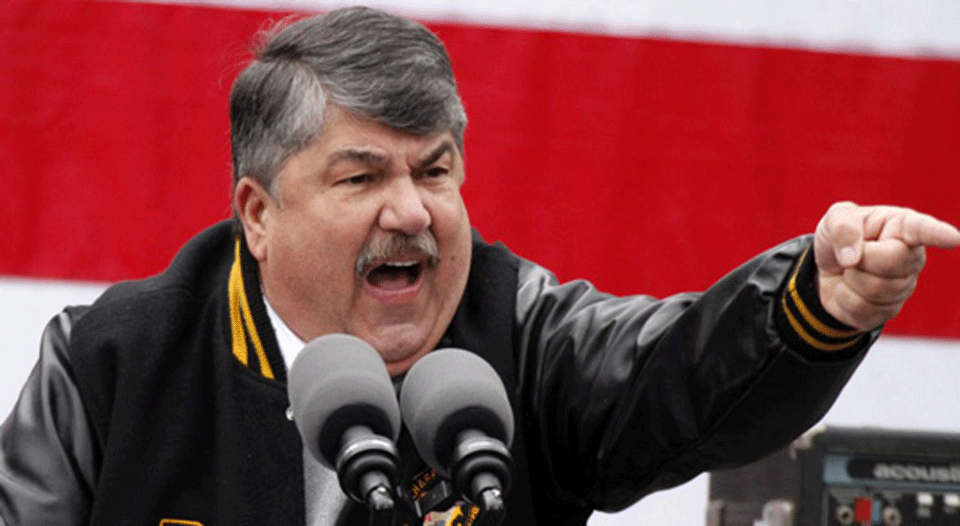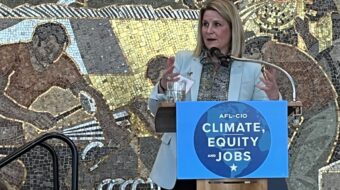
WASHINGTON—Crash.
That was the sound of the U.S. economy collapsing in April as the official unemployment rate skyrocketed from 4.4% in March to 14,7% last month, the Bureau of Labor Statistics said. And that is an enormous undercount with many millions still unable to get their claims registered. Official totals of 20 million could be as high as 50 million, according to AFL-CIO President Richard Trumka. Even the BLS says its figures are an undercount. Undercount.
“If the persons who were recorded as employed but ‘absent from work for other reasons’ had been classified as unemployed but on temporary layoff, the overall unemployment rate would have been almost five percentage points higher,” BLS noted.
The news was even worse in terms of actual numbers and economic sectors, thanks to the mass closures ordered to achieve social distancing needed to combat the spread of the coronavirus pandemic. In so many words, much of the economy tanked.
The number of unemployed rose in one month from 7.14 million to 23.08 million, seasonally adjusted, BLS reported. That 15.94 million-person increase doesn’t count another 3.169 million people who filed for unemployment insurance in the last week of April, which ended on May Day, along with multiple millions in the weeks before that.
It also doesn’t count people so discouraged they stopped seeking jobs or those forced to work part-time. Adding them in means 22.8% of workers were unemployed or underemployed.
And those newly jobless workers, who became unemployed after BLS’s survey week ended on April 18, pushed the end-of-April jobless figure to at least 33.5 million, BLS’s weekly jobless claims report said the day before. The monthly report was based on the mid-April BLS survey.
“Behind all these numbers are real people,” AFL-CIO President Richard Trumka said the day before, citing now-jobless workers in Florida and Philadelphia, whose families depend on their paychecks to live – and who lost not just jobs, but health insurance, too.
They’re also people of color: The jobless rate among Hispanic-named people more than tripled, from 6% in March to 18.9% in April. The rate for adult African-Americans rose by 10 percentage points, to 16.7%.
“Our federal government and our Congress must act swiftly and boldly,” Trumka said in his 13-minute speech on the AFL-CIO’s Facebook feed. “You have two jobs right now,” he told lawmakers. “One, keeping people alive. Two, keeping people on the payroll. And end the pandemic politics now.”
The April figures also don’t count, as both the Economic Policy Institute and Trumka pointed out, millions more jobless people who couldn’t get through to file claims with state-run jobless agencies as their overburdened computer and phone systems crashed.
Trumka then endorsed having the federal government pick up the paychecks for the jobless, with employers acting as pass-through vehicles – while banning funds to Wall Street and CEOs. Rep. Pramila Jayapal, D-Wash., co-chair of the House Progressive Caucus, has proposed just that, covering each jobless worker’s pay up to $100,000, plus health care coverage, and Trumka cited her by name. He noted one right-wing senator backs the concept.
The depression actually began in March, as closures accelerated to combat the coronavirus and its community spread. Unemployment in March was 0.9% higher than in February (3.5% then). Private sector businesses shed 870,000 jobs in March, a figure BLS revised upwards by more than 150,000. But March’s slide paled compared to April’s disaster.
EPI and Trumka both noted that for every ten callers filing jobless claims in April, at least four more could not. He said the real number of jobless could be as high as 50 million. That’s one-third of the workforce – higher than the official jobless share at the depths of the Great Depression in 1932. At that official low, one of every four workers was jobless.
BLS also noted 7.46 million adult men lost jobs in April, as did 7.14 million women.
People of color were especially hard-hit in April by mass unemployment as industries they labor in – retail, restaurants, hotels, bars, child care, health care among them – shed tons of jobs. And joblessness among African-American teenagers, whose unemployment rate is always the highest of any demographic group, rose from 24.1% in March to 28% in April.
Whole sectors of the economy just closed up shop, a separate survey of businesses showed. Hotels, restaurants and bars said they went from 13.93 million jobs combined in March – already down 459,000 then — to 7.59 million in mid-April. They’re headed even lower than their April jobless rate of 39.3%. Unite Here’s locals in Las Vegas reported 90%-95% unemployment last month.
Performing arts, museums, and sports, combined in the BLS data, went from 683,800 jobs in March to 409,000 in April, even before every venue from jazz joints to the Metropolitan Opera shuttered. Leaders of performing arts, stage technicians, directors, and similar unions said in a telephone press conference two days before that working performers, which includes part-timers and their gigs, went from an estimated four million to virtually zero.
Even health care lost two million jobs in April. So did teachers: down 644,900, including higher ed. Overall, the jobless rate in services soared from 4% in March to 27.1% in April.
Factories lost jobs, declining from 12.82 million in March to 11.49 million in April, as hundreds of plants shuttered. The nation’s car companies, especially the Detroit 3, shut down. Car firms had 995,500 workers in March and 614,000 in April. Overall, 1.99 million factory workers were jobless in April (13.2%), compared to 636,000 in March (4.2%).
Construction was even worse. Construction firms reported shedding 29,000 jobs in March, down to 7.605 million. They let another 975,000 workers go in April, and construction joblessness rose to 16.6% and a total of 1.53 million workers.












Comments